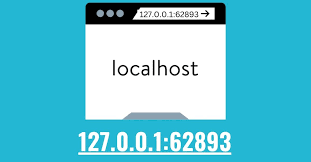In the vast and intricate world of computer networking, certain terms and numbers frequently appear yet remain mysterious to many. One such enigmatic figure is “127.0.0.1:62893.” To the untrained eye, this combination of numbers might seem like random digits, but within the realm of networking, it holds significant meaning. The IP address “127.0.0.1” is commonly known as localhost, representing a computer’s loopback interface. The number “62893” following the colon is a port number, serving as an access point for various network services. Together, they form a key that unlocks the communication pathways within your computer system.
Understanding the Basics: What is 127.0.0.1?
The address “127.0.0.1” is known as the loopback address or localhost. When you type this address into your browser, you are essentially telling your computer to look at itself. In simpler terms, “127.0.0.1” is the way your computer talks to itself. This loopback address is crucial for developers who need to test applications on their own machines without affecting live environments. It’s a safe space where they can run servers, execute commands, and troubleshoot issues before deploying them to the real world.
The Role of Port Numbers: Why 62893?
While “127.0.0.1” serves as the address, “62893” is the port number, which directs traffic to the appropriate service. Think of a port number as a specific door in a large building. The IP address gets you to the building, but the port number tells you which door to use to access the service you need. In this context, “62893” could represent any service or application running on your local machine. Different services use different port numbers, allowing multiple services to operate simultaneously without interference.
How Localhost and Port Numbers Work Together
When you combine “127.0.0.1” with a port number like “62893,” you create a unique address that directs network traffic within your computer. For instance, if a web server is running on your machine and listening on port 62893, typing “127.0.0.1:62893” into your browser will take you directly to that server’s interface. This combination is especially useful for developers who need to test multiple applications or services on their local machines. Each service can be assigned a different port, ensuring that traffic is routed correctly without conflicts.
Why Developers Rely on Localhost for Testing
Localhost is a critical tool for developers, allowing them to simulate how applications will behave in a live environment. By using “127.0.0.1,” developers can run web servers, databases, and other services on their local machines without needing internet access. This setup provides a controlled environment where they can experiment, debug, and refine their applications. The use of specific port numbers, such as “62893,” ensures that different services don’t interfere with each other, making the testing process smoother and more efficient.
Security Implications: Keeping Localhost Secure
While localhost is a powerful tool, it also comes with security considerations. Because “127.0.0.1” is only accessible from the local machine, it is generally safe from external threats. However, developers must still exercise caution. Misconfigured services or vulnerable applications running on localhost could be exploited if other users gain access to the machine. Ensuring that only necessary services are running and that they are properly secured is crucial. Additionally, developers should avoid using default port numbers for sensitive services, as these are more likely to be targeted.
Common Use Cases for 127.0.0.1:62893
The combination of “127.0.0.1” and a specific port number like “62893” is commonly used in various scenarios:
- Web Development: Developers use localhost to test websites and web applications before deploying them to production. They can run multiple instances of a web server on different ports, allowing for simultaneous testing.
- Database Management: Localhost is often used to host databases during development. By accessing “127.0.0.1” on a specific port, developers can interact with databases, run queries, and manage data locally.
- API Testing: Application Programming Interfaces (APIs) can be tested locally by running them on a specific port. This allows developers to make requests and see how the API responds before it goes live.
- Software Prototyping: New software applications can be developed and tested on localhost, ensuring that they function correctly before being released to users.
- Security Research: Security professionals often use localhost to test vulnerabilities in a controlled environment, preventing any real-world impact.
Troubleshooting Common Issues with Localhost
Despite its benefits, working with localhost can sometimes present challenges. One common issue is the “port already in use” error, which occurs when multiple services attempt to use the same port. To resolve this, developers can either stop the conflicting service or assign a different port number. Another issue is firewall settings that block access to localhost, which can be fixed by adjusting the firewall rules. Understanding these common problems and their solutions is key to effectively using localhost in development.
Exploring Alternatives to Localhost
While localhost is a valuable tool, there are alternatives that developers might consider depending on their needs. Virtual machines and containers, such as Docker, offer isolated environments for running applications, making them ideal for more complex testing scenarios. Cloud-based development environments, like Gitpod or AWS Cloud9, allow developers to write and test code directly in the cloud, providing scalability and collaboration features. These alternatives complement localhost by offering additional flexibility and resources.
The Future of Localhost in Development
As development practices evolve, the role of localhost is likely to change. With the rise of cloud computing and DevOps practices, more developers are moving towards cloud-based environments for testing and deployment. However, localhost will remain an essential tool for quick testing and prototyping. Its simplicity, accessibility, and speed make it irreplaceable for certain tasks. Future advancements in development tools may further integrate localhost with cloud environments, creating a hybrid approach that leverages the strengths of both.
Why 127.0.0.1:62893 Still Matters
Despite the rapid pace of technological advancement, the combination of “127.0.0.1” and specific port numbers remains a cornerstone of development work. It provides developers with a reliable, controlled environment for testing and troubleshooting. Whether you’re a seasoned professional or just starting, understanding how to effectively use localhost and port numbers is fundamental to your success. The ability to test locally before deploying to live environments is a skill that will always be in demand.
Conclusion
The address “127.0.0.1:62893” may seem like a random string of numbers, but it represents a critical concept in computer networking. Localhost and port numbers form the backbone of many development processes, allowing for safe, efficient testing and troubleshooting. By mastering these tools, developers can ensure their applications are robust, secure, and ready for the real world. As technology continues to evolve, the principles behind “127.0.0.1:62893” will remain relevant, proving that even the simplest concepts can have a profound impact on the world of technology.

